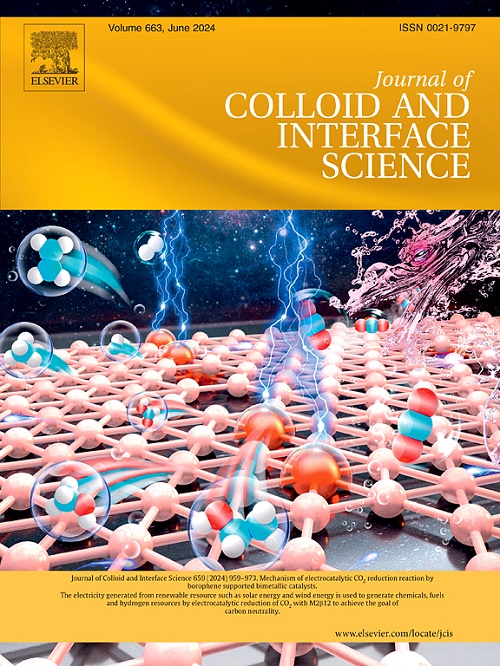二氧化碳光还原成多碳燃料的共价有机框架中金属中心和孔拓扑的双重调制
IF 9.7
1区 化学
Q1 CHEMISTRY, PHYSICAL
引用次数: 0
摘要
光催化CO2还原生成C2+产物(C2H4, C3H6)是实现碳中和目标的一条有希望的途径。然而,金属中心和孔隙拓扑结构之间的内在关系,对C2+产物活性有显著影响,仍有待阐明。本文设计了三种具有不同孔隙拓扑结构的共价有机框架(COFs),并通过后修饰策略引入了金属中心。BT-COF-Cu的光催化CO2还原活性显著优于其原始COF和参考铜COFs, C2H4和C3H6的C2+产率分别为12.9 μmol·g−1·h−1和0.8 μmol·g−1·h−1。这种性能的增强是由于金属中心与孔隙拓扑结构之间的协同作用。这种独特的星形Kagome拓扑结构不仅促进了载流子快速迁移到金属活性中心进行还原反应,而且还促进了二氧化碳的吸附和活化,共同提高了二氧化碳的光还原活性。本研究为高效太阳能转换和应用的金属COFs孔拓扑设计提供了新的视角。本文章由计算机程序翻译,如有差异,请以英文原文为准。

Dual modulation of metal center and pore topology in covalent organic frameworks for photoreduction of carbon dioxide to multi‑carbon fuels
The photocatalytic CO2 reduction yielding C2+ products (C2H4, C3H6) represents a promising pathway to achieve the goal of carbon neutrality. Nevertheless, the intrinsic relationship between metal center and pore topology, which has a significant effect on C2+ product activity, remains to be elucidated. Herein, three covalent organic frameworks (COFs) with varying pore topologies were designed and metal centers were introduced through a post-modification strategy. The photocatalytic CO2 reduction activity of BT-COF-Cu significantly surpasses that of its pristine COF and the reference copper COFs, exhibiting C2+ product yields of 12.9 μmol·g−1·h−1 for C2H4 and 0.8 μmol·g−1·h−1 for C3H6. The enhanced performance is attributed to the synergistic interaction between the metal center and the pore topology. This unique star-shaped Kagome topology not only facilitates rapid charge carrier migration to metal active centers for reduction reactions, but also boosts CO2 adsorption and activation, collectively enhancing CO2 photoreduction activity. This work provides a new perspective on the pore topology design of metallic COFs for efficient solar energy conversion and applications.
求助全文
通过发布文献求助,成功后即可免费获取论文全文。
去求助
来源期刊
CiteScore
16.10
自引率
7.10%
发文量
2568
审稿时长
2 months
期刊介绍:
The Journal of Colloid and Interface Science publishes original research findings on the fundamental principles of colloid and interface science, as well as innovative applications in various fields. The criteria for publication include impact, quality, novelty, and originality.
Emphasis:
The journal emphasizes fundamental scientific innovation within the following categories:
A.Colloidal Materials and Nanomaterials
B.Soft Colloidal and Self-Assembly Systems
C.Adsorption, Catalysis, and Electrochemistry
D.Interfacial Processes, Capillarity, and Wetting
E.Biomaterials and Nanomedicine
F.Energy Conversion and Storage, and Environmental Technologies

 求助内容:
求助内容: 应助结果提醒方式:
应助结果提醒方式:


